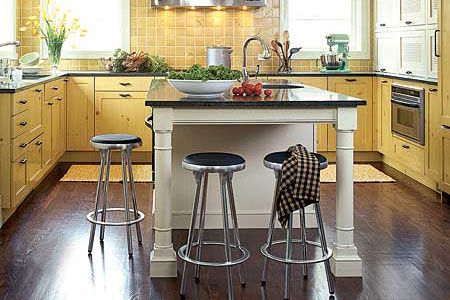Kitchen islands have become a staple in modern home design, offering both functionality and aesthetic appeal. These versatile structures serve as the heart of the kitchen, providing additional workspace, storage, and a gathering spot for family and friends. In this article, we’ll explore kitchen island design ideas to help you create the perfect centerpiece for your culinary space.
The Benefits of a Kitchen Island
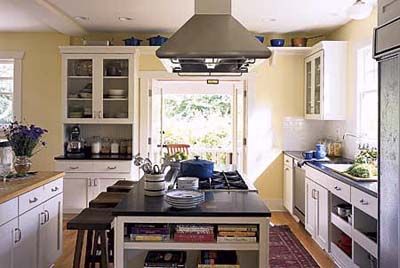
Kitchen islands have stood the test of time, outlasting many passing fads in home design. Their enduring popularity stems from their ability to seamlessly blend form and function, making them a must-have feature for many homeowners. Islands serve as a multifunctional space where cooking, socializing, and even homework can coexist harmoniously.
One of the key benefits of a kitchen island is its ability to foster social interaction while maintaining a practical workspace. As renowned British kitchen designer Johnny Grey notes, “Why would you want to prep food with a wall or a cabinet door a few inches from your nose, or eyes for that matter? An island that faces into the center of the room is the place for prepping and cooking. Sociability is not possible without eye contact.”
This design philosophy emphasizes the importance of creating a space that encourages conversation and connection by allowing the cook to remain engaged with guests or family members. Islands can also serve as an informal dining area, a homework station for children, or a buffet surface for entertaining.
Kitchen Space Considerations
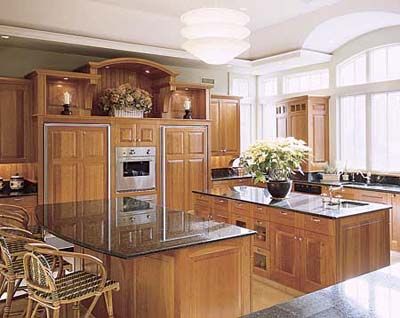
When planning a kitchen island, size and space are crucial factors. While there’s no one-size-fits-all approach, standard guidelines can help ensure your island is both functional and proportionate to your kitchen’s dimensions.
Architect Duo Dickinson recommends that an island be at least 4 feet long and slightly more than 2 feet deep, with ample room to move around it. “Unless your kitchen is at least 8 feet wide and more than 12 feet long, don’t even think about an island,” he advises.
The National Kitchen and Bath Association (NKBA) provides more specific guidelines for clearance around an island:
- A minimum of 36 inches between the island’s perimeter and surrounding cabinetry or appliances
- 42 inches of clearance for a single-cook kitchen
- 48 inches of clearance for a multiple-cook kitchen
These measurements ensure comfortable movement and prevent the kitchen from feeling cramped. Consider these space requirements before committing to an island, especially in smaller kitchens where space is at a premium. Larger kitchens offer more flexibility.
Color for Variety and Focus in the Kitchen
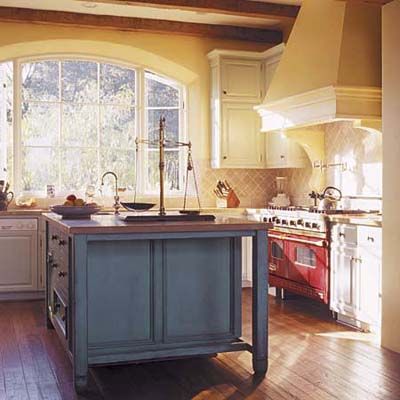
A well-designed kitchen island can serve as a striking focal point, especially when it features a contrasting color scheme. This approach adds visual interest and helps define the island as a distinct element within the kitchen space.
Consider these color strategies for your kitchen island:
- Bold accents: Use a vibrant hue to make the island pop against a neutral kitchen backdrop.
- Complementary colors: Choose a color that complements the main kitchen cabinetry while providing contrast.
- Two-tone approach: Combine two colors on the island itself, such as a darker base with a lighter countertop.
While the island’s cabinetry style may match the rest of the kitchen, varying the color, finish, or countertop material can create a unique and eye-catching design. This contrast can help delineate the island’s various functions, such as food preparation, dining, or storage areas. A thoughtfully chosen color scheme can also tie together different design elements in your kitchen for a cohesive look.
Multi-Level Kitchen Counter Heights
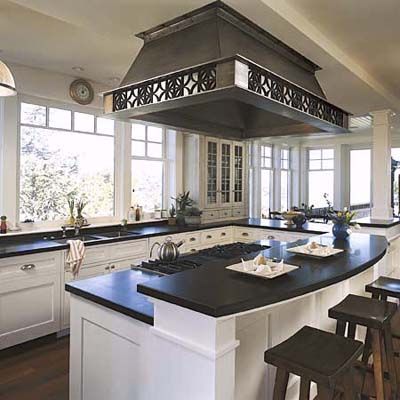
Incorporating different counter heights in your kitchen island design can enhance functionality and visual appeal. This approach allows for a clear separation of tasks while catering to various needs and preferences.
A multi-level island typically features:
- A lower level for food preparation and cooking
- A raised level for casual dining or as a serving area
- A mid-level section for specific tasks like baking (potentially)
The varying heights not only create distinct zones but also add architectural interest to the kitchen. For instance, a lower cooking surface allows the chef to interact with seated guests at eye level for a more social cooking experience.
Factor in safety considerations, especially in households with young children. The proximity of a higher dining surface to a lower cooking area could pose risks, such as spills reaching hot cooking surfaces. If you have small children, you might want to reconsider this arrangement or implement additional safety measures. Or, you might opt for design features like raised edges to provide a buffer between activity zones.
A Good Place To Put Kitchen Appliances
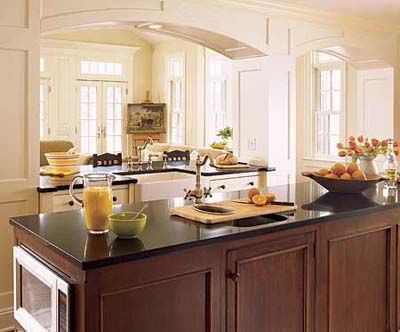
Kitchen islands offer a great opportunity to integrate various appliances, streamlining your kitchen’s functionality while maintaining a clean, uncluttered look. By incorporating appliances into the island, you can free up wall space and create a more open feel in your kitchen.
Some appliances that work well in kitchen islands include the following:
- Beverage centers or wine coolers
- Cooktops or ranges
- Dishwashers
- Garbage disposals
- Microwave ovens
- Warming drawers
When planning appliance placement on your island, think about workflow and ergonomics. For example, positioning a dishwasher near the sink can make cleanup more efficient. A cooktop on the island allows the chef to face guests while cooking, enhancing the social aspect of meal preparation.
The 10-foot island pictured above allowed the designer to minimize appliances seen at eye level, putting more focus on the character of the cabinetry. Plan for electrical outlets and ventilation to support the appliances you choose.
Kitchen Storage Considerations
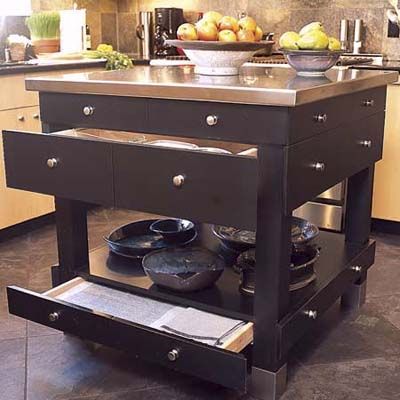
One of the most significant advantages of a kitchen island is the additional storage it provides. With thoughtful design, an island can become a central storage hub, housing everything from cookware and serving dishes to linens and small appliances.
Consider these storage options for your kitchen island:
- Cabinets for storing less frequently used appliances or bulk items
- Large drawers for pots, pans, and other cookware
- Open shelving for frequently used items or decorative pieces
- Pull-out trash and recycling bins
- Specialized storage solutions like spice racks or knife blocks
Think about accessibility and frequency of use. Items used daily should be easily reachable, while less frequently used items can be stored in harder-to-reach areas. Customizable inserts and dividers can further optimize your island storage.
While open shelving can be visually appealing and provide easy access to items, these areas may collect dust or become cluttered if not maintained regularly. If you opt for open shelving at foot level, it might become a resting place for feet, potentially compromising cleanliness.
Furniture Style Island
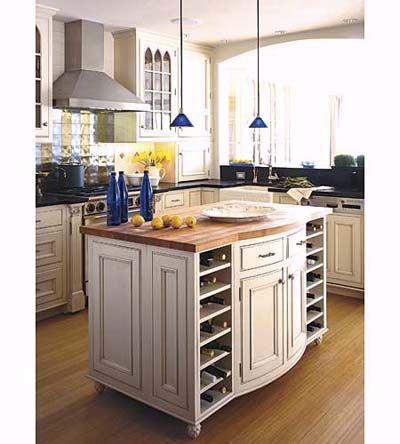
A furniture-style kitchen island can add a touch of elegance and personality to your kitchen. This design treats the island as a standalone piece of furniture rather than an extension of the kitchen cabinetry, creating a focal point that enhances the overall design.
A furniture-style island might include the following features:
- A different finish or wood type from the main cabinetry
- Decorative elements like turned legs or ornate moldings
- Open shelving or glass-front cabinets for display
- Unique hardware that complements the island’s style
In the example provided, the island incorporates wine storage racks and decorative pineapple feet, giving it the appearance of a fine piece of furniture. However, it doesn’t sacrifice functionality with its large butcher-block top, microwave, pull-out trash bin, and ample storage for kitchen essentials.
This approach allows you to introduce a different style or era into your kitchen design, creating an eclectic look that adds character and warmth to the space. It’s a good choice in transitional or traditional kitchen designs, where it can serve as a bridge between old and new elements. Furniture-style islands can be tailored with custom details that reflect your personal taste.
Kitchen Traffic Zones
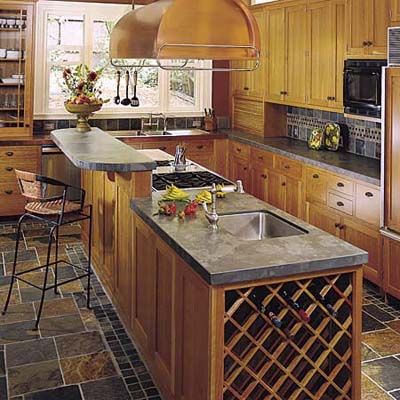
When designing a kitchen island, consider how it will affect traffic flow in your kitchen. A well-planned island can improve workflow and create distinct zones for various activities, while a poorly placed one can obstruct movement and create bottlenecks.
Consider these factors when planning your island’s layout:
- Activity zones: Create distinct areas for food prep, cooking, cleaning, and dining.
- Appliance placement: Position appliances on the island to complement the overall kitchen workflow.
- Clearance: Allow enough space (at least 36 inches) around the island for comfortable movement.
- Work triangle: Ensure the island doesn’t disrupt the flow between the sink, refrigerator, and cooktop.
In the example provided, a long, narrow island creates distinct zones for different activities. The wine storage and prep sink at one end create a bar area for entertaining, while the raised countertop provides a visual barrier between the dining area and the chef’s workspace.
While a long island offers excellent functionality, it may require more walking to circumnavigate. This layout works best in larger kitchens where there’s enough space to move around the island. Strategic planning ensures that high-traffic areas are free from obstruction.
Island Stool Storage
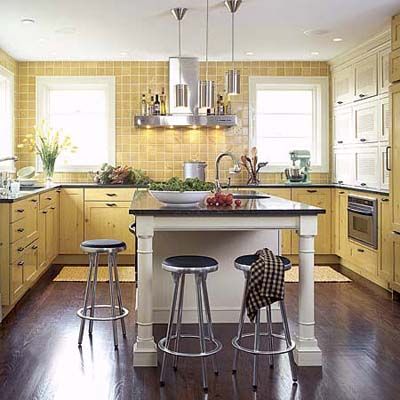
Incorporating seating into your kitchen island design is a popular choice, but think through where these stools or chairs will be stored when not in use. Clever stool storage solutions can help maintain a clutter-free kitchen and maximize space efficiency.
Here are some ideas for stool storage:
- Pull-out storage compartments within the island
- Recessed areas under the countertop overhang
- Stackable or nesting stools that can be tucked away
- Stools that slide completely under the counter when not in use
In kitchens where space is limited, the area beneath the island’s overhang can serve as an excellent storage spot for stools. This approach keeps the stools readily accessible while maintaining a clean, uncluttered look.
When choosing stools for your island, consider their height, style, and how well they complement your kitchen’s overall design. Backless stools are easy to store, but if comfort is a priority, opt for stools with backs that can still be tucked away neatly. Upholstered stools can provide a touch of luxury and comfort, making your kitchen island a welcoming spot for guests and family members.
Island Sink
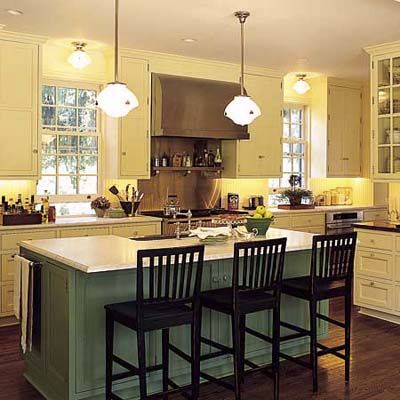
Incorporating a sink into your kitchen island can enhance its functionality and improve your kitchen’s overall workflow. An island sink provides a convenient spot for food preparation, cleanup, and socializing while performing kitchen tasks. Placing a sink in a kitchen island also allows you to opt for a larger, more luxurious sink.
When planning for an island sink, consider these factors:
- Dishwasher placement: If possible, position the dishwasher near the sink for efficient cleanup.
- Lighting: Provide adequate task lighting above the sink area.
- Plumbing requirements: Ensure proper drainage and venting can be accommodated.
- Surrounding counter space: Allow ample room on either side of the sink for tasks and dish drying.
While an island sink offers many advantages, there are potential challenges. Installing plumbing in an island can be more complex and costly than in a traditional counter against a wall. Plus, local building codes may have specific requirements for sink venting in islands, so consult with a professional plumber or contractor before finalizing your design. They can help you ensure the island has sufficient structural support for the additional weight of the sink and its plumbing.
